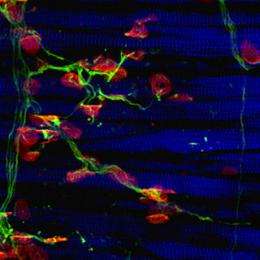Scientists discover master regulator of motor neuron firing

(PhysOrg.com) -- When the Human Genome Project was complete, DNA bowed out of the limelight and gave way to RNA as a major player in genetic regulation. Now, findings at Rockefeller University mirror this ideological shift, revealing that one of the most important physiological events in the body — the wiring of motor neurons and muscles — is regulated at the level of RNA. The findings upturn dogma in the field and further point to the increasingly indisputable role of RNA as the molecule behind biological complexity.
The research, led by Robert B. Darnell, head of the Laboratory of Molecular Neuro-oncology, and former research associate Matteo Ruggiu, now a postdoctoral research scientist at Columbia University, highlights the workings of the neuromuscular junction, where axons of motor neurons meet the muscle. At this junction, these tendril-like extensions synapse specifically onto clusters of receptors, allowing the brain to transmit messages that signal the muscle to either contract or relax. The deterioration of the neuromuscular junction is at the center of Lou Gehrig’s disease.
Since the 1980s, the master architect of the neuromuscular junction was thought to be a specific form of a protein known as agrin. Designated Z+ agrin, this form of the protein is found only in neurons and has an extra piece of RNA spliced into the transcript. To many, a key question that remained was which splicing factor is responsible for slipping in this extra piece, the Z+ exon.
In their work, Darnell and Ruggiu not only unmask the splicing factor but also reveal that this factor, not Z+ agrin, is the master regulator that orchestrates the formation of the neuromuscular junction. Past experiments had led scientists to conclude that Z+ agrin might be necessary and sufficient for the neuromuscular junction to form properly, but Darnell and Ruggiu show that while Z+ agrin is necessary, other proteins are also needed.
The splicing factor the scientists identified is a well-studied protein called NOVA, which comes in two varieties. The team found that mice that were genetically engineered to lack both varieties, NOVA1 and NOVA2, and thus Z+ agrin, were born paralyzed. “They couldn’t move a muscle,” says Darnell. “So that’s when we decided to look at the neuromuscular junction.” The researchers found that the receptor clusters on the muscle were few and sparse and those that remained did not form very many connections with nerve ends.
Based on the reigning doctrine, they expected that restoring Z+ agrin in mice that lacked NOVA would be enough to rescue the mice. “But that was not the case,” says Ruggiu. “And that was very surprising because when we looked at the morphology of the neuromuscular junction, it looked normal. The Z+ agrin restored the receptor clusters and synapses, but that didn’t do the animals any good: They remained paralyzed.”
“So that’s a paradox,” says Darnell, who is also a Howard Hughes Medical Institute investigator. “And that’s a good place to be in science. That’s where you want to be because it means that the dogma in the field is wrong.”
Since the muscle looked normal, they turned their attention to the motor neuron and got another surprise. Working with Gerald Fischbach, a visiting professor at Rockefeller, the group artificially stimulated the motor axon and found that it was fully able to transmit electrical impulses to secrete its neurotransmitter and cause the muscle to twitch, even though the mice remained completely paralyzed. A more refined picture began to emerge: While Z+ agrin restores the cluster of receptors at the junction, it doesn’t restore the ability of the motor neurons to fire.
“What that means is that, since the targets regulated by NOVA are still defective in the Z+ agrin-rescued mice, one or more of the many NOVA-regulated transcripts must be responsible for triggering an action potential,” says Ruggiu. “It’s a novel discovery because nobody has ever postulated that an RNA binding protein could regulate motor neuron firing.”
“It opens up a whole new vista on RNA regulation of neuronal function,” adds Darnell.
More information: Proceedings of the National Academy of Sciences 106(9): 3513-3518 (March 3, 2009) Rescuing Z+ agrin splicing in Nova null mice restores synapse formation and unmasks a physiologic defect in motor neuron firing, Matteo Ruggiu, Ruth Herbst, Natalie Kim, Marko Jevsek, John J. Fak, Mary Anne Mann, Gerald Fischbach, Steven J. Burden and Robert B. Darnell
Provided by Rockefeller University (news : web)











